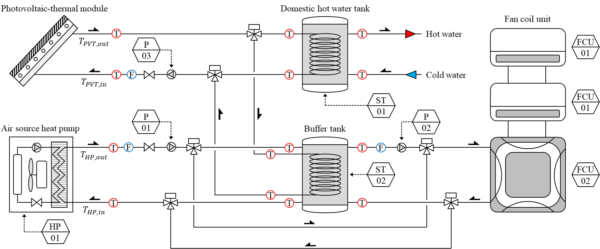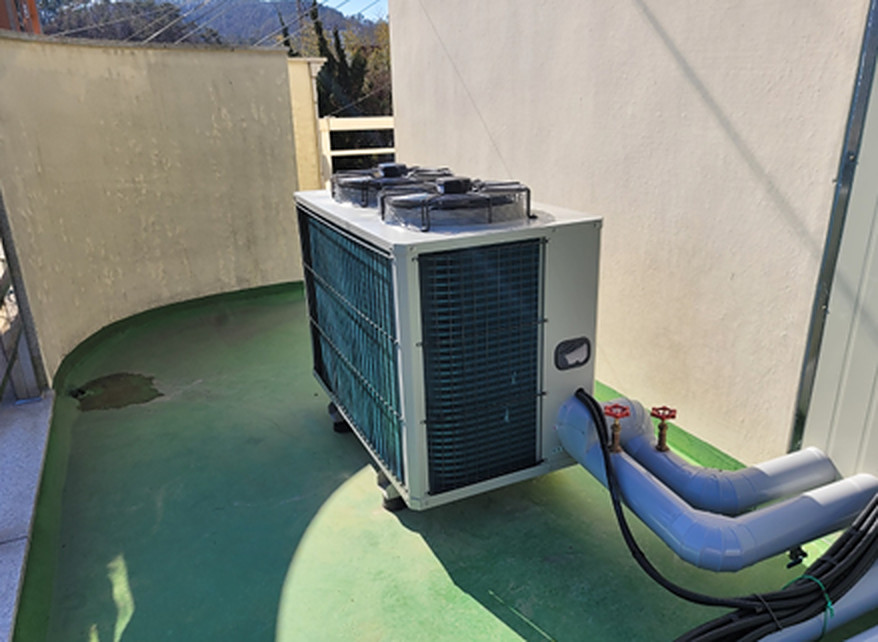Researchers at the Pusan National University in South Korea have designed an integrated system based on a photovoltaic-thermal (PVT) unit and an air source heat pump (ASHP) for deployment in zero-energy buildings (ZEBs) with limited space.
In such buildings, the total sum of annual energy use is approximately equal to the total sum of the renewable energy produced on-site. “Our system has been designed to meet all the heating, cooling, domestic hot water, and electricity demand of a ZEB,” the research's corresponding author, Sangmu Bae, told pv magazine.
The scientists explained that the proposed system configuration offers more advantages compared to integrated PVT ground source heat pumps (GSHP), which have so far had limited success in real applications in urban areas due to the complex installation process and high initial costs.
The system consists of a PVT module, an ASHP, a heat storage tank with a volume of 0.3 m3, a fan coil unit (FCU), three circulating pumps, and three-way valves.
The 1.012 m × 1.972 m PVT panel is based on main and capillary pipes of diameters of 0.015 m and 0.008 m, respectively, which the academics said are easy to fabricate and weld. “The pipes were fully clamped and attached through the aluminum jig and plate, and the groove in the plate had available spaces considering the expansion of the pipe,” they explained.

Image: Pusan National University
The module achieves thermal and electric efficiencies of 59.7% and 16.1%, as well as heating and cooling capacities equal to 7.55 kW and 11.36 kW, respectively.
The Korean group evaluated the heating and cooling performance of the PVT–ASHP system in a small scale office building located in Busan and compared it with that of a PVT-GSHP. “The mock-up test room included a monitoring room,” it said. “The air-conditioning areas of the office and the monitoring rooms were equal to 85.8 m2 and 22.1 m2, respectively.”
During the testing period, the system reached a thermal efficiency of 18.1% and an output of 37 kWh. It also achieved electrical efficiency of 11.4% on a winter day and 10.2% on a summer day. The electrical output was 8.84 kWh and 12.9 kWh, respectively.
“The electrical efficiency was lower than on a representative winter day,” the scientists further explained. “However, the PVT module could generate more electrical power owing to the higher total solar radiation and longer sunlight hours.”
The heat pump also achieved an average heating and cooling coefficient of performance (COP) of 3.54 and 3.31, respectively. The PVT module was able to improve the performance of the heat pump by up to 52% compared to an ASHP system without PVT energy.
“The PVT module could offset approximately 18% and 27% of the total power consumption of the PVT–ASHP system during the
winter and summer seasons, respectively,” the scientists said, adding that the proposed system is also around 44% cheaper than a PVT-GSHP.
They presented the system in the study “Experimental analysis of an integrated system using photovoltaic–thermal and air source heat pump for real applications,” published in Renewable Energy.
This content is protected by copyright and may not be reused. If you want to cooperate with us and would like to reuse some of our content, please contact: editors@pv-magazine.com.




1 comment
By submitting this form you agree to pv magazine using your data for the purposes of publishing your comment.
Your personal data will only be disclosed or otherwise transmitted to third parties for the purposes of spam filtering or if this is necessary for technical maintenance of the website. Any other transfer to third parties will not take place unless this is justified on the basis of applicable data protection regulations or if pv magazine is legally obliged to do so.
You may revoke this consent at any time with effect for the future, in which case your personal data will be deleted immediately. Otherwise, your data will be deleted if pv magazine has processed your request or the purpose of data storage is fulfilled.
Further information on data privacy can be found in our Data Protection Policy.